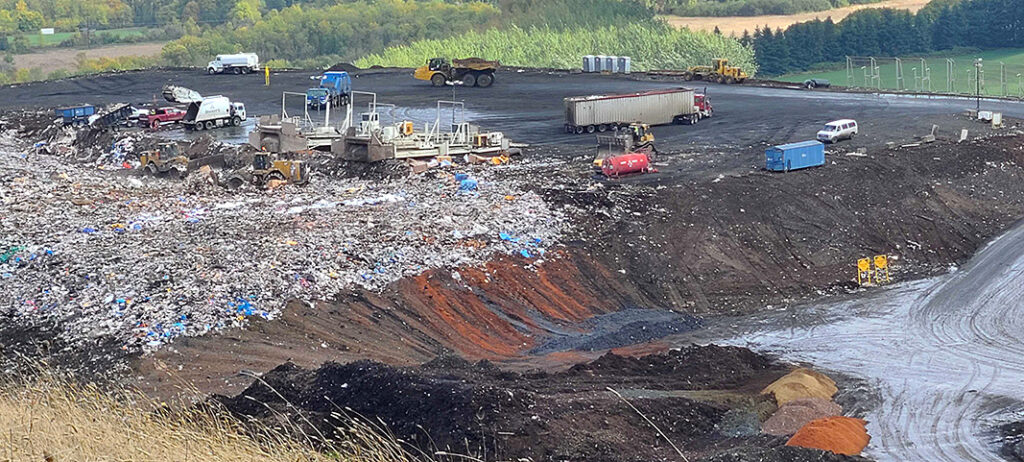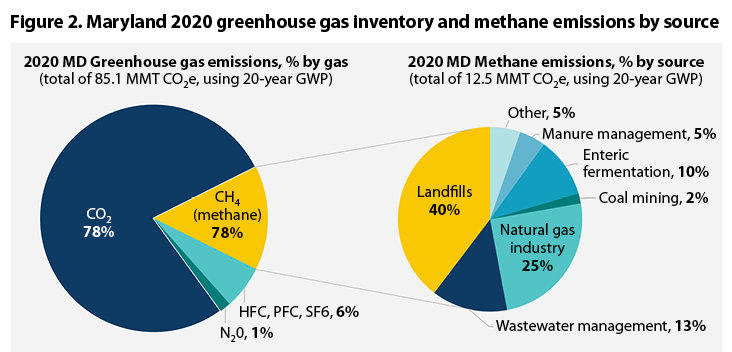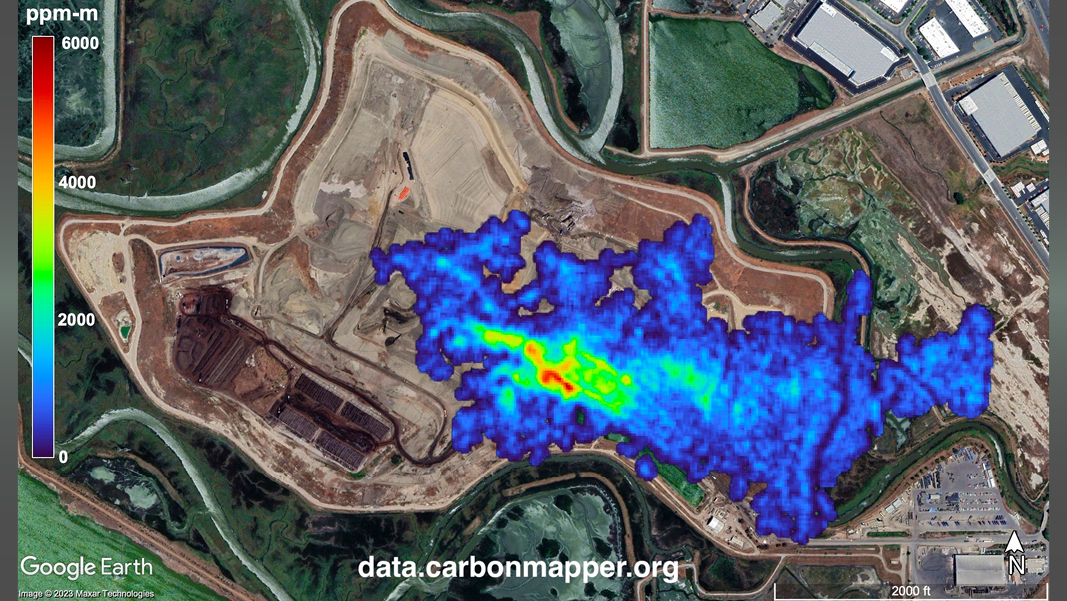Top: Plume of methane emissions at a landfill detected by a Carbon Mapper airborne survey using NASA Jet Propulsion Laboratory Next Generation Airborne Visible Infrared Imaging Spectrometer (AVIRIS-NG).
Katherine Blauvelt and Ellie Garland
More than one year after the passage of the Inflation Reduction Act (IRA), it’s hard to understate the impact of the landmark climate law: from boosting electric vehicle and battery manufacturing to unlocking billions of dollars in consumer rebates for clean cars, appliances, and home improvements. One new grant program tucked away in the IRA empowers communities to cut local greenhouse gas (GHG) emissions, including from an often overlooked source — landfills.
The Climate Pollution Reduction Grants (CPRG) program sets aside $5 billion for states, local governments, tribes, and territories to advance ambitious, community-driven GHG reduction strategies. The program, administered by the U.S. Environmental Protection Agency (EPA), is structured in two phases: $250 million in formula grants to develop climate action plans, followed by $4.6 billion in competitive grants to implement those plans. EPA has awarded the planning grants, and recipients now have until Spring 2024 to develop and submit their first deliverable: a Priority Climate Action Plan (PCAP). The PCAP is a prerequisite to compete for implementation funding, and only GHG reduction measures identified in the PCAP are eligible. The deadline to submit the PCAP is March 1, 2024 for states and metropolitan areas, and April 1, 2024 for tribes, tribal consortia, and territories. Implementation grant applications are due one month following the PCAP: April 1, 2024 for the general competition, and May 1, 2024 for the tribes and territories only competition.
Time Sensitive Opportunity to Weigh In
Right now, states, tribes, territories, and local governments across the country are developing or updating their climate action plans, building GHG inventories, and identifying projects that can be submitted for implementation grant funding. Businesses, organizations, nonprofits, and community members can identify planning grantees in their region (Figure 1) and encourage inclusion of organics diversion and landfill methane strategies in their local climate action plans. The window for getting involved is short. A new resource from RMI and Industrious Labs — Priority Climate Action Plan Guide: Organic Waste & Landfill Methane Strategies — provides information and examples to facilitate inclusion of organic waste and landfill methane control strategies in the PCAP by the March and April 2024 deadlines.
Landfills are a major source of local GHG pollution that planning grant recipients can tackle in the PCAP. Across the United States, there are more than 1,200 active municipal solid waste (MSW) landfills that emit methane, a short-lived but highly potent GHG. Methane is generated in landfills as organic waste decomposes, and a new EPA analysis finds that food waste is responsible for 58% of landfill methane emissions. In 2021, U.S. MSW landfills emitted an estimated 3.7 million metric tons of methane, equivalent to about 295 million metric tons of carbon dioxide (mmtCO2e) on a 20-year timeline or the annual GHG pollution from driving 66 million gas-powered passenger cars.
Cutting methane is one of the strongest levers we have to fight climate change. By including landfill methane GHG reduction measures in the PCAP, state and local governments can make immediate, dramatic emissions reductions and bring substantial community benefits, particularly to low-income and disadvantaged communities that too often live in close proximity to landfills. Strategies to reduce methane — by keeping food and other organic waste out of landfills and strengthening landfill emissions controls — are technically feasible, readily available, and cost-effective. Waste and materials management received less dedicated IRA funding than other sectors, making the CPRG program a powerful and complementary opportunity for methane reductions.

More than 1,200 active landfills in the U.S. emit methane, a short-lived but highly potent GHG. Photo courtesy of Industrious Labs and RMI.
PCAP Key Elements And Considerations
The Priority Climate Action Plan is a focused list of “near-term, high-priority, implementation-ready measures” to reduce local climate pollution. There are four required elements: a GHG inventory, quantified GHG reduction measures, a low-income and disadvantaged communities (LIDAC) benefits analysis, and a review of authority to implement. Developing a strong plan will position planning grant recipients well to compete for implementation funding. Here are some key considerations from the RMI-Industrious Labs Guide for incorporating organic waste and landfill emissions strategies into each required element of the PCAP:
GHG Inventory:
- Focus on methane sources to identify high-impact, near-term GHG reduction opportunities.
- Use 20-year global warming potential (GWP), as in Maryland Department of Environment’s GHG inventory (Figure 2), to adequately reflect the benefits of cutting methane, a short-lived climate pollutant with about 80 times the warming power of carbon dioxide over 20 years.

- Improve inventory accuracy with jurisdiction-specific data on waste composition and landfill methane leakage.
- Industrious Labs’ dashboard tracks reported landfill methane emissions by state down to the community level, and the EPA provides several tools to develop GHG inventories for states, local governments, and tribes. Tools may default to a 100-year GWP; replacing that value with the 20-year GWP will ensure methane sources are represented on a climate-relevant timeline.
Quantified GHG Reduction Measures:
- Include upstream measures, like organic waste prevention, edible food donation and composting, to prevent methane generation and ensure organic materials are put to their highest and best use, as outlined in EPA’s recently updated Wasted Food Scale.
- Include downstream measures, such as stronger state emissions regulations that improve landfill gas capture and reduce fugitive landfill emissions, to cut methane quickly from waste-in-place and protect nearby communities.
- Organic waste bans (e.g., California SB 1383) and state landfill emissions regulations (e.g., Maryland Landfill Methane Rule) are two high-impact, complementary measures that achieve the multiple goals of the CPRG program and will position grantees well to unlock additional funding in the CPRG implementation phase.
Low Income and Disadvantaged Communities Benefits Analysis (LIDAC):
- GHG reduction strategies that strengthen landfill methane controls can also reduce emissions of hazardous air pollutants, volatile organic compounds, and odors — helping to improve air quality, health outcomes, and quality of life for nearby communities, many of whom are disproportionately low-income or communities of color. Strategies to prevent and divert organic waste from landfills can also help reduce odors, minimize leachate generation and associated groundwater pollution, and prevent landfill expansion.
- Consider the full range of potential benefits to low-income and disadvantaged communities from addressing food insecurity to creating circular economy jobs to increasing climate resiliency through compost application.
Authority To Implement:
- State and local governments have broad authority and responsibility for waste management, putting implementation-ready measures firmly in reach. There are many existing programs and policies to reduce organic waste disposal and strengthen landfill emissions controls that planning grant recipients can build from.
- Pursue interagency and intergovernmental collaboration to advance big picture strategies.
- Leverage complementary federal funding sources to support implementation.
For more recommendations, examples, and resources, check out the Guide. The Climate Pollution Reduction Grant program is a historic opportunity to fund landfill methane reductions, and our window to act is now.
Katherine Blauvelt is Circular Economy Director at Industrious Labs, which focuses on scaling campaigns and building a movement to clean up heavy industry through network and capacity building, research and analysis, data-driven campaigns, and sharp communications. Its interactive 50-state dashboard displays landfill emissions as dontwasteourfuture.org. Ellie Garland is a Senior Associate at RMI, an independent, nonpartisan, nonprofit organization working to secure a clean, prosperous, zero carbon future for all. RMI’s memo series highlights opportunities to cut U.S. landfill methane emissions; its Energy Policy Simulator (EPS) is a free-to-use, publicly available, open-source model that can estimate the environmental, economic, and human health impacts of climate and energy policies to support CPRG planning













